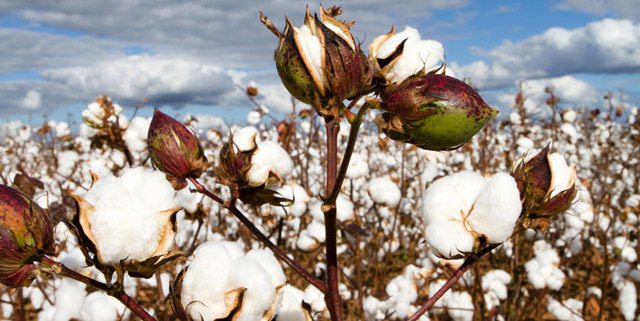RECENT PRICE MOVEMENT
All benchmark prices decreased over the past month.
- The May NY/ICE futures contract fell from 88 to 78 cents/lb between early March and early April. In later trading, prices have rebounded to levels near 82 cents/lb.
- The December NY/ICE futures contract fell from values around 85 cents/lb in early March to those as low as 76 cents/lb near the end of that More recently, prices recovered to levels near 82 cents/lb.
- The China Cotton Index (CC Index 3128B) fell from 114 to 106 cents/lb over the past month. In domestic terms, prices fell from 16,300 to 15,300 RMB/ton. The RMB has weakened against the dollar since early March, from 52 to 6.56 RMB/USD.
- Indian spot prices eased from 80 to 78 cents/lb in international In domestic terms, values decreased from 45,800 to 45,400 INR/candy. The INR was relatively stable against the dollar over the past month, holding near 73 INR/USD.
- Pakistani spot prices declined from 95 to 87 cents/lb in international In domestic terms, values fell from 12,300 to 10,800 PKR/maund. The PKR strengthened against the dollar over the past month, from 157 to 153 PKR.USD.
SUPPLY, DEMAND, & TRADE
The latest USDA report featured a small decrease in global production (-276,000 bales to 113.0 million) and a small increase in global mill-use (+387,000 bales to 117.8 million). An upward revision to world mill-use last crop year drove 2020/21 beginning stocks lower (-427,000 bales to 98.4 million).
The net effect of lower beginning stocks, lower production, and higher consumption was a 1.1 million bale reduction to the forecast for 2020/21 ending stocks (to 93.5 million bales). Nonetheless, the current figure for the global stocks-to-use ratio still ranks among the top six on record, and the current estimate for the world-less-China stocks-to-use ranks among the top two in the modern era (since 2000/01).
At the country-level, the only notable change was for Australia (-100,000 bales to 2.5 million).
For mill-use, the largest revisions included those for China (+250,000 bales to 39.8 million), Bangladesh (+200,000 bales to 7.7 million), Mexico (+150,000 bales to 1.7 million), and Indonesia (-150,000 bales to 2.4 million).
The global trade forecast swelled 947,000 bales to 45.5 million. In terms of imports, the largest changes were for China (+750,000 to 11.8 million), Bangladesh (+200,000 to 7.4 million), Pakistan (+100,000 to 5.3 million), and Indonesia (-150,000 bales to 2.3 million). In terms of exports, the largest changes were for Brazil (+500,000 bales to 10.5 million), the U.S. (+250,000 to 15.8 million), and Egypt (+125,000 bales to 0.3 million).
PRICE OUTLOOK
Cotton prices were already trending lower when the U.S., the E.U., U.K., and Canada issued joint sanctions on a few Chinese individuals accused of human rights abuses on March 22nd. Relative to the ban on Xinjiang content that the U.S. imposed on January 13th, these sanctions can be viewed as largely symbolic. Nonetheless, the announcement provoked a reaction in China, triggering boycott efforts against several western apparel companies.
Following these developments, there were steeper declines in cotton prices. These losses may have been driven out of concern for the trade relationship between the U.S. and China. China accounts for 32% of the current U.S. export commitment for 2020/21 delivery, and China has taken 39% of U.S. shipments so far this crop year.
In each of the five past crop years, China accounted for less than 20% of U.S. exports. The increase in China’s share of U.S. exports comes from a meteoric rise in Chinese purchases in 2020/21. U.S. exports to China are up 276% year-over-year. The strength of Chinese demand has been the driver of the 15% year-over-year growth in overall U.S. shipments this crop year. Excluding China, U.S. exports are down 20% year-over-year.
The importance of Chinese demand to U.S. exports creates uncertainty for the market. In the Phase One deal, China promised to increase agricultural purchases in the 2021 calendar year (+$7.0 billion beyond 2020 levels). If fulfilled, this could be a factor that pulls U.S. stocks tight in 2021/22. If political tension between the two countries causes the deal to be abandoned, a negative reaction in prices could be expected.
Meanwhile, demand from other markets should improve. COVID vaccines are being distributed. Along with fiscal and monetary stimulus, the hope that the pandemic will be contained has lifted forecasts for economic growth.
The International Monetary Fund (IMF) just released a prediction that the global economy will expand 6.0% in 2021. This represents the strongest rate of growth in nearly five decades. Although some recovery in cotton consumption has already been enjoyed in 2020/21, global GDP growth is correlated with global mill-use. The acceleration in economic growth predicted in 2021 suggests a further boost to mill demand into 2021/22.
For price direction, any increase in global mill-use will have to be balanced against production and stocks. The USDA will issue its first complete set of supply, demand, and trade forecasts next month. Although the weather, COVID, and trade policy will continue to create uncertainty for the outlook, their projections will help inform expectations for 2021/22.
Monthly Economic Letter – April 2021
Disclaimer: The information contained herein is derived from public and private subscriber news sources believed to be reliable; however, Cotton Incorporated cannot guarantee its accuracy or completeness. No responsibility is assumed for the use of this information and no express or implied warranties or guarantees are made. The information contained herein should not be relied upon for the purpose of making investment decisions. This communication is not intended to forecast or predict future prices or events.
